Increasing the sustainability of organic waste in mining
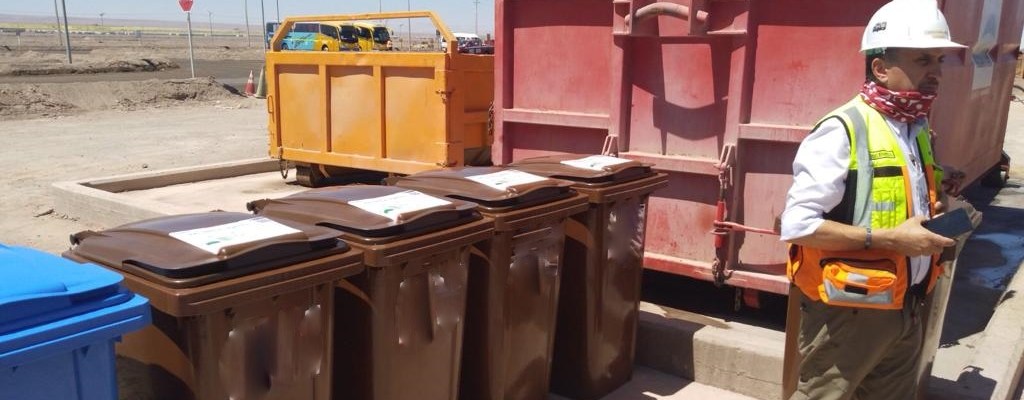
As announced in May 2020, AusIMM is collaborating with Green Eco Technologies to showcase waste-reduction opportunities for the conversion and re-purposing of putrescible organic waste.
This article looks at Green Eco Technologies’ WasteMaster system, the technology behind it, and the benefits of reducing food waste as the industry continues to find ways to increase site sustainability.
One of the critical issues impacting the environment is the damaging effect of organic waste in landfill, which is a major contributor to greenhouse gas generation.
This is because rotting organic waste in landfill produces methane, one of the more active greenhouse gases (NASA, 2020). The emission of one tonne of methane is equivalent to discharging 34 tonnes of CO2 (Stocker et al, 2013). In fact, the contribution of food waste emissions to global warming is almost equivalent (87 per cent) to those generated by global road transport (Scialabba, 2015).
The World Preservation Foundation (WPF; 2016) has stated that by concentrating on mitigating methane production instead of CO2, the world can start to reduce global warming much faster. A 50 per cent reduction in methane emissions would equate to cutting CO₂ emissions by 100 per cent by 2050.
Zero waste to landfill is often quoted as an essential target to mitigate the damaging effects of waste on the environment. This is generally understood to mean a minimum of 99 per cent of generated waste being diverted from landfill, and instead being reused, recycled, composted or even used to recover energy (Jones, 2017).
Finding ways to achieve this challenging goal must be a priority to stem the damaging effects of greenhouse gases in the future.
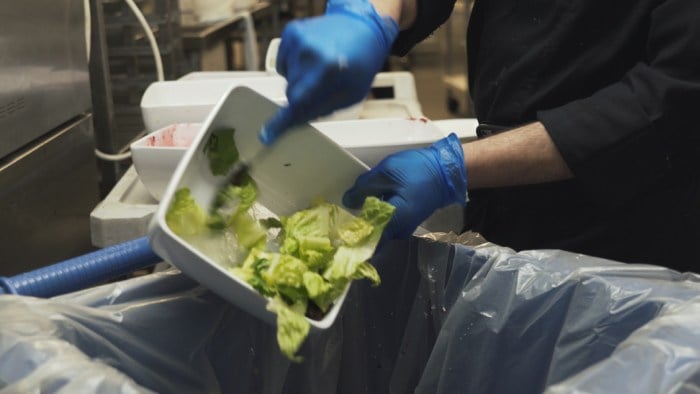
United Nations Global Sustainability Targets
In 2015 the United Nations (UN) established 17 Sustainable Development Goals (SDGs). Each of the SDGs represents an urgent call to action and incorporates a benchmark for all nations to improve environmental wellbeing and secure a sustainable future for the planet by 2030. Responsible food and organic waste disposal supports the aims of SDGs six, 12, 13, 14 and 15 (Figure 1).

Life cycle, recycling, and reutilisation
For unavoidable food waste, the best solution is to find other uses for this valuable resource so that nothing is wasted. The Circular Economy is described by Circular Regions (via Circular Oslo) as: ‘replacing the end-of-life concept…with the goal of sustainable development, which implies environmental quality, economic prosperity and social equality for the benefit of current and future generations’ (2020; Figure 2) and by WRAP as ‘extracting maximum value from resources’ (2020). These principles provide direction for us to sustainably manage the waste we generate for future benefit, rather than adding to an alarming global environmental burden.
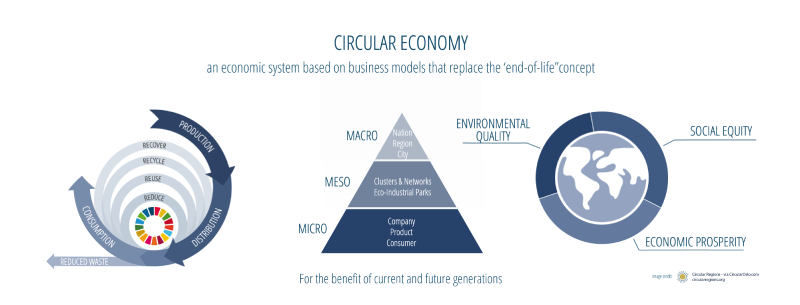
Australia is changing the way it thinks about waste, not only the means of disposal, but also how it is generated. Changing to a circular economy way of thinking, many are pre-emptively considering how products can have a further life as resources to retain as much value as possible, while also having a positive net effect on the environment through reduced waste.
The Australian Government National Waste Policy (2018) provides guidelines for governments, businesses, communities and individuals to work together up to 2030 to tackle waste responsibly, reducing the amount of waste generated and instead creating further resources according to the principles of a circular economy.
Impact mitigation in the mining industry
There are almost 250,000 people either directly employed or associated in some way with mining operations in Australia (Australian Government Labour Market Information Portal, 2020). In common with many sectors employing large workforces, the responsible disposal of waste, including organic waste, is a major consideration for the industry. Sustainability, and particularly the mitigation of any negative impacts on the environment, are key priorities for mining companies and many have set targets to reduce their environmental impact. Strategies and road maps are in place to achieve these goals, with indicators defined to demonstrate the advancements being made (Hancock, 2001; Segura-Salazar 2018).
Of the 10 key guidance principles defined by the International Council on Mining and Metals (ICMM, 2020), five, six, seven and eight relate to health and safety, environmental performance, conservation of biodiversity and responsible production respectively (Figure 3). All of these have relevance for mining companies and their management of waste.

Waste processing technology for the resources sector
A major consideration for any method used to deal with waste is its potential or consequential environmental impact. No or Low Emissions Technologies (LETs) are a responsible way forward to slow or preferably stop the damaging environmental impacts of waste.
With the health and safety of employees and visitors to sites of prime importance, multiple non- operational vehicle movements can represent unnecessary hazards. Moreover, degrading or rotting food waste stored on site, often in high temperatures while awaiting collection, must also be carefully handled to ensure there is no risk of contamination. Remotely operated or monitored technology can also minimise the health and safety risks associated with direct machine operation on site.
Processing and recycling waste on site is a practical way to reduce the amount of food waste generated by a mining operation, and can also both prevent the generation of methane from the decomposition of food waste in landfill and reduce the CO2 carbon footprint from transporting this waste to and from mining sites. There are also the additional health and safety advantages mentioned above.
An example of a technology that combines on-site processing with the re-purposing of food waste to prevent methane generation is the WasteMaster system. Harnessing Australian technology, the WasteMaster has been developed to tackle the health and safety and emissions challenges of food waste disposal.
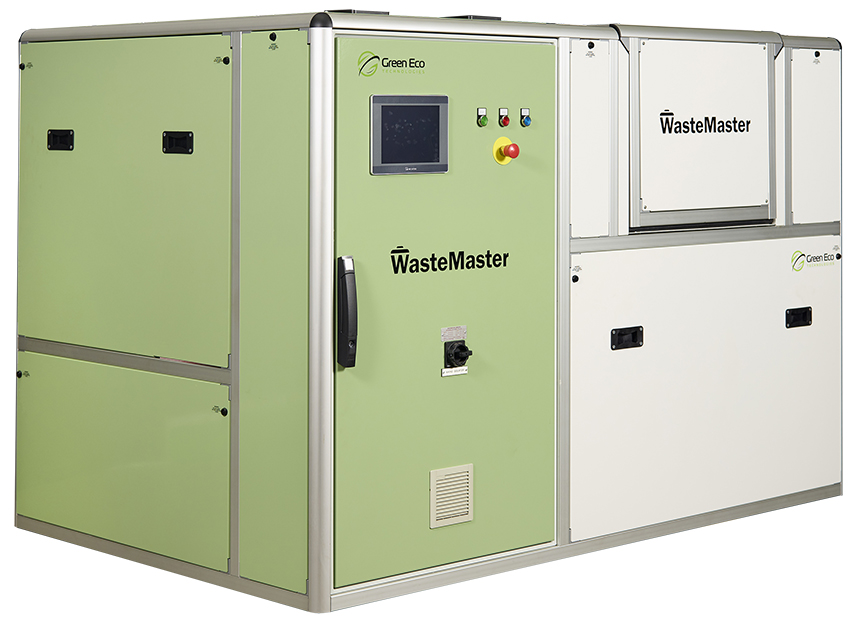
Converting food waste on site, the WasteMaster’s proprietary technology accelerates the decomposition of food and organic waste without water or any additives. Food waste is oxidised through ionisation, releasing water as vapour and transforming the waste during a short processing cycle into a compost-like, storable, pathogen-free residual material (Figure 4). This high-calorific value residue can be re-purposed as green energy through anaerobic digestion and is presently being assessed by testing facilities around the world for other purposes such as soil enhancement.
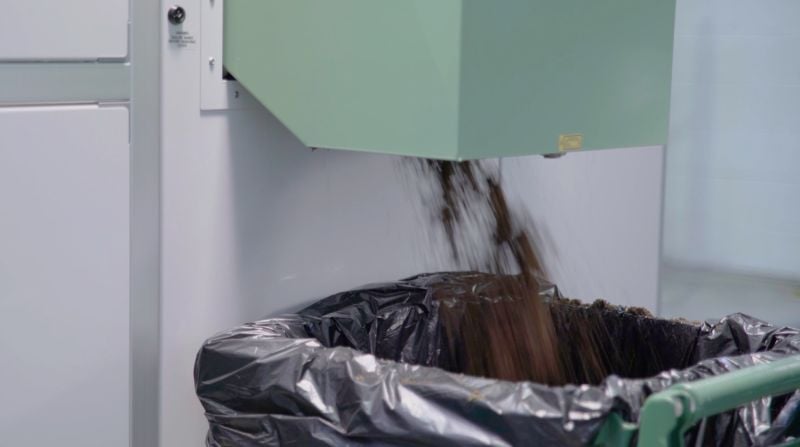
The system’s operation is monitored and optimised remotely via a diagnostic system, which also accurately measures the amount of waste processed for sustainability reporting purposes.
The WasteMaster is also Worksafe compliant in providing a food waste conversion system that minimises employee exposure to operational hazards (for example, see the WorkSafe priority ‘Areas of focus’ as published on the Western Australian Government Department of Mines, Industry Regulation and Safety website).
Independent life-cycle analysis carried out by Deakin University, which compared WasteMaster on-site food waste conversion to landfill disposal, found an 84 per cent equivalent reduction in greenhouse gas generation, taking into account both disposal and transport. Additional testing and research estimates that for every two tonnes of food waste fed into the WasteMaster and diverted from landfill, around 3.2 tonnes of greenhouse gases are prevented (Environmental Risk Sciences Pty Ltd, 2015).
The WasteMaster technology has been installed and tested extensively at high-volume catering sites including restaurants, hotels, large canteens and hospitals. A large hotel with multiple restaurants has been using the system for four years, reducing its environmental footprint through the conversion of food waste on site, sending the remaining residual material for the generation of green energy and implementing waste reduction programs based on the accurate waste data provided by the remote diagnostic system.
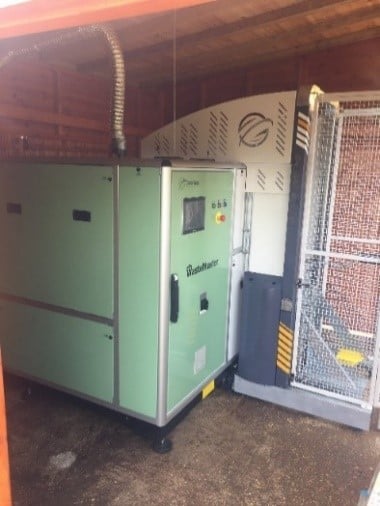
Epworth Healthcare, Victoria’s largest not-for-profit private hospital group, has been using the WasteMaster conversion system to change food waste into reusable residue, thereby reducing its environmental impact. The group has successfully diverted nearly 10 tonnes of food waste from landfill, sending the converted residue to an anaerobic digester, and generating 2610kWh of energy – enough to power 191 homes for a day.
Conclusion
Globally, it is essential that we do whatever we can to safeguard the environment, and environmental sustainability is now at the core of mining companies’ operating practices. Greatly reducing the amount of food waste sent to landfill is another way companies can continue to show their commitment to a sustainable future. By adopting technology that will minimise the impact of organic waste, the mining industry can both improve sustainability and help to support the future preservation of our planet.
For more information contact enquiries@greenecotec.com or call +61 416 243 613
References
Australian Government Department of Agriculture, Water and the Environment, 2018. ‘National Waste Policy’ [online]. Available from: https://www.environment.gov.au/protection/waste-resource-recovery/national-waste-policy
Australian Government Labour Market Information Portal, 2020. ‘Mining’ [online]. Available from: https://lmip.gov.au/default.aspx?LMIP/GainInsights/IndustryInformation/Mining
Circular Regions (via Circular Oslo), 2020. ‘What is the circular economy?’ [online]. Available from: https://circularoslo.com/
Environmental Risk Sciences Pty Ltd, 2015. Independent Research – Review and Explanation of Waste and Emissions Data.
Government of Western Australia Department of Mines, Industry Regulation and Safety (2020). ‘About WorkSafe: Priority areas (areas of focus)’ [online]. Available from: https://www.commerce.wa.gov.au/worksafe/priority-areas-areas-focus
Hancock, 2001. Sustainable Development and the Australian Minerals Sector, Australian Parliament Research Paper 24 2000-01, [online]. Available from: https://www.aph.gov.au/About_Parliament/Parliamentary_Departments/Parliamentary_Library/pubs/rp/rp0001/01R P24
International Council on Mining and Metals, 2020. ‘Mining principles’ [online]. Available from: https://www.icmm.com/mining-principles
IPCC, 2013: Climate Change 2013: The Physical Science Basis. Contribution of Working Group I to the Fifth Assessment Report of the Intergovernmental Panel on Climate Change [Stocker, T.F., D. Qin, G.-K. Plattner, M. Tignor, S.K. Allen, J. Boschung, A. Nauels, Y. Xia, V. Bex and P.M. Midgley (eds.)]. Cambridge University Press, Cambridge, United Kingdom and New York, NY, USA, 1535 pp. Available from: https://www.ipcc.ch/report/ar5/wg1/
Jones M, 2017. ‘What is “zero waste to landfill?” [online]. Available from: https://www.carbontrust.com/news-and-events/insights/what-is-zero-waste-to-landfill.
NASA, 2020. ‘The Causes of Climate Change’ [online]. Available from: https://climate.nasa.gov/causes/
Scialabba, 2015. Food wastage footprint and climate change [online]. Available from: http://www.fao.org/3/a-bb144e.pdf
Segura-Salazar J, 2018. ‘Sustainability in the Minerals Industry: Seeking a Consensus on Its Meaning’ Department of Metallurgical and Materials Engineering, Universidade Federal do Rio de Janeiro [online]. Available from: https://www.mdpi.com/2071-1050/10/5/1429
United Nations, 2020. ‘Sustainable development goals’ [online]. Available from: https://sustainabledevelopment.un.org/sdgs
World Preservation Foundation, 2016. ‘Methane’ [online]. Available from: https://worldpreservationfoundation.org/environment/methane/
Wrap, 2020. ‘WRAP and the circular economy’ [online]. Available from: http://www.wrap.org.uk/about-us/about/wrap-and-circular-economy
